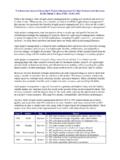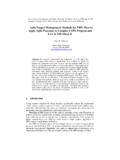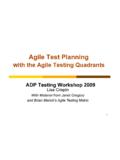Transcription of WHAT IS THE ROI OF AGILE VS. TRADITIONAL …
1 Page - 1 - WHAT IS THE ROI OF AGILE VS. TRADITIONAL methods ? An analysis of XP, TDD, Pair Programming, and Scrum (Using Real Options) Dr. David F. Rico, PMP, CSM Abstract Little is known about the costs and benefits of AGILE methods since their popularization in 1999, though 67% of projects use them and 75 books and 100s of papers have been written about them. The purpose of this article is to analyze the costs and benefits reported in studies of new product development approaches such as AGILE methods as compared to those of TRADITIONAL methods . Over 300 articles on AGILE methods were examined; cost, schedule, productivity, quality, and customer satisfaction data were found in 69 studies; and ROI data were identified in 29 studies. AGILE methods ROI was four times more than expensive TRADITIONAL methods , two times less than inexpensive ones, and the best AGILE and TRADITIONAL methods had equal ROI (see Figure 1).
2 However, it may not be proper to compare TRADITIONAL methods optimized for productivity and quality to AGILE methods optimized for customer satisfaction, project success, and risk reduction. Introduction The and worldwide information technology industry continues to grow at an amazing rate. In 2006, software industry revenues reached $393 billion, and business-to-consumer (B2C) and business-to-business (B2B) electronic commerce revenue reached $220 billion and $ trillion. Likewise, the number of Internet websites now exceeds 136 million, the number of Internet shoppers is in excess of 147 million, and the number of Internet users is greater than billion. 1 Accordingly, information technology is the second leading contributor to the economy and contributes to more than 50% of labor productivity growth in the top 10 industrialized nations.
3 Also in 2006, firms spent over $251 billion in information technology investments and the Department of Defense used $447 billion to acquire information technology based systems. This flurry of activity led to more than 6 million information technology jobs, 450,000 projects, 265,000 certified project managers, and 36,000 Scrum masters to help manage them. Finally, 900,000 firms used ISO 9001 for quality management, 300,000 projects used AGILE methods for software design, and 840 firms used CMMI for process improvement in 2006. 4,133%3,272%2,826%1,788%871%229%173%0%50 0%1,000%1,500%2,000%2,500%3,000%3,500%4, 000%4,500%PSPsmInspectionsTSPsmAgileSW-C MM ISO 9001 CMMI Figure 1. methods for Managing Information Technology Projects (with decreasing ROI from left to right) Personal Software Process (PSP), Team Software Process (TSP), Software-Capability Maturity Model (SW-CMM), and Capability Maturity Model Integration (CMMI) are registered in the Patent and Trademark Office by Carnegie Mellon University (CMU).
4 Page - 2 - AGILE methods AGILE methods are lightweight software design processes based on small teams using flexible technologies to iteratively improve software using customer feedback to converge on solutions. Kent Beck is credited with creating AGILE methods by devising Extreme Programming in 1998, though XP was just one in a long line of hundreds of software methods dating back to 1968. 2 According to the AGILE Manifesto, the major factors of AGILE methods are: (1) early customer involvement, (2) iterative development, (3) self-organizing teams, and (4) adaptation to change. Early customer involvement was known as top-level commitment, management involvement, user involvement, user participation, lead users, and participatory design from 1950 to 1980.
5 Iterative development was known as concept testing, beta testing, and probing in marketing and iterative, incremental, evolutionary, spiral, and time-boxed development in the software field. Self organizing teams were known as self organizing dynamic teams, self determined groups, small decision-making groups, task oriented groups, and autonomous groups up to the 1960s. Adaptability came from organismic biology, cybernetics, systems theory, systems dynamics, double loop learning, adaptive organizations, learning organizations, and systems thinking. Thomas Edison s success is attributed to the use of AGILE , new product development processes, along with Lockheed s SR-71, NASA s Apollo program, and the Jet Propulsion Laboratory. 3 But, direct antecedents of AGILE methods include Joint Application Design, Rapid Application Development, Participatory Design, Synch-and-Stabilize, Judo Strategy, and Internet Time.
6 4 AGILE methods include Extreme Programming, Scrum, Feature Driven Development, Dynamic Systems Development, Lean Development, Crystal methods , and Adaptive Software Design. 5 By 2003, 66% of the world s projects were using AGILE methods and 90% of those were using Extreme Programming (XP), 6 although the number of projects using XP has declined to 23%. 7 The number of software projects using Scrum is increasing and it has caught the fancy of big firms like Google, Yahoo, and Microsoft, and as many as 50,000 projects may be using Scrum. The latest trend is to mix-and-match Scrum and XP to tap into practices like Pair Programming (PP) and Test-Driven Development (TDD) to increase productivity and quality (see Figure 2). 8 AGILE methods have capabilities beyond TRADITIONAL methods That is, the ability to successfully deliver results quickly and inexpensively on complex projects with ill-defined requirements.
7 Figure 2. AGILE methods and Practices (with often-reported costs and benefits)Page - 3 - AGILE methods Costs and Benefits A primary goal of this study was to examine scholarly studies of AGILE methods and survey the range of quantitative costs and benefits associated with the use of AGILE methods (see Table 1). Data were compared to costs and benefits of TRADITIONAL methods such as CMMI (see Table 2). 9 AGILE methods emphasize teams, working software, customer collaboration, and responding to change, while TRADITIONAL methods focus on contracts, plans, processes, documents, and tools. 10 The SEI study identified 99 data points on cost, schedule, productivity, quality, satisfaction, and ROI gains from 25 organizations as reported by CMMI -related literature from SEI conferences.
8 It s important to note that CMMI data are optimistic and often come from CMMI proponents, rather than scholarly research studies such as experiments, surveys, or other scientific methods . Oftentimes, the percentages are only relative proportions and do not state the actual costs and benefits ( , large CMMI initiatives cost millions of dollars and oftentimes do not succeed). Some of these data came from mixing and matching TRADITIONAL methods such as Inspections, PSPsm, TSPsm, Six Sigma, and others to gain synergy not possible within a CMMI environment. Nonetheless, these data represent a major milestone in the research on TRADITIONAL methods for software process improvement, software development, and information systems (IS) research. Two similar studies on the costs and benefits of SW-CMM were gathered by the Data and Analysis Center for Software (DACS) 11 and software development researchers in Israel.
9 12 Table 1. AGILE methods Costs and Benefits No. Category Low Median High Points 1. Cost 10% 26% 70% 9 2. Schedule 11% 71% 700% 19 3. Productivity 14% 122% 712% 27 4. Quality 10% 70% 1,000%53 5. Satisfaction 70% 70% 70% 1 6. ROI 240% 2,633% 8,852%29 Table 2. TRADITIONAL methods Costs and Benefits No. Category Low Median High Points 1. Cost 3% 20% 87% 21 2. Schedule 2% 37% 90% 19 3. Productivity9% 62% 255% 17 4. Quality 7% 50% 132% 20 5. Satisfaction-4% 14% 55% 6 6. ROI 200% 470% 2,770%16 Using the SEI cost and benefit summary as a framework, cost, schedule, productivity, quality, satisfaction, and ROI data were gathered from over 300 scholarly articles about AGILE methods .
10 In Table 1 and Table 2, the category represents the benefits of AGILE and TRADITIONAL methods , while the low, median, and high represent the range of reported benefits within each category. This was a laborious process, because relevant articles on AGILE methods had to be identified and categorized, and then cost and benefit data had to be extracted and normalized for comparison. The original goals were limited in scope and consisted of gathering a small amount of data in order to gain an appreciation for the range of costs and benefits possible with AGILE methods . However, this quickly blossomed into a two-month long effort due to the number of studies on AGILE methods , the amount of data, and the process of data cleansing for comparative analysis.











